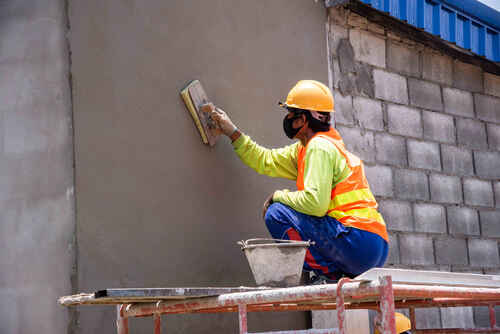A Comprehensive Overview to Learning Plastering Abilities for Your Renovation Needs

Essential Devices and Products
In the world of plastering, having the right tools and materials is paramount to attaining a remarkable surface. Different important tools offer unique purposes, guaranteeing efficiency and precision throughout the smudging process. A top notch trowel, for circumstances, is important for smoothing and using plaster, while a hawk offers a steady platform for holding the product. A joint blade is likewise essential for comprehensive job, especially in sides and corners.
In addition to devices, choosing the ideal plastering materials is essential. Gypsum-based plasters are frequently preferred for their adaptability and ease of use, while cement-based alternatives are optimal for exterior applications because of their resilience. Water and bonding representatives play significant functions in achieving appropriate consistency and attachment, guaranteeing that the plaster sticks successfully to the surface area.
Furthermore, protective equipment such as masks, goggles, and handwear covers is necessary to safeguard against dirt and irritability during the application process. By constructing the best mix of devices and products, plasterers can enhance their capability and generate high-quality finishes, ultimately raising the general workmanship of their job.
Preparing Surface Areas for Smudging
Achieving a smooth and resilient plaster surface starts with thorough prep work of the surface areas to be plastered. This foundational action is crucial to making sure adhesion and the longevity of the plaster. Begin by examining the problem of the substratum-- whether it is masonry, concrete, or drywall-- eliminating any kind of loosened paint, dirt, or particles that might hinder bonding.
Following, fix any type of flaws such as fractures or holes. Make use of an appropriate filler to attain a level surface; this can be vital for stopping future concerns. When repaired, ensure the surface area is completely dry and clean, as moisture can endanger plaster adherence.
For porous surfaces, it is suggested to use a bonding agent. This item enhances attachment and develops a dependable user interface in between the plaster and substratum. If dealing with formerly plastered surface areas, it may be essential to scuff or sand the area gently to supply a secret for the brand-new plaster layer.
Gluing Techniques and Tips
Grasping gluing techniques calls for both skill and technique to achieve a remarkable finish. One necessary technique is the application of the plaster in several slim layers, rather than a single thick layer.
When using the finish layer, utilize a troweling method that entails holding the trowel at a slight angle and working in a round activity. This assists to produce a smooth surface area and reduces the appearance of trowel marks. Furthermore, maintain a spray container of water handy to mist the surface gently; this maintains the plaster workable and enables smoother completing.
Timing is important; work efficiently, as the plaster starts to set. As soon as the plaster has firmed up but is still wet, make use of a damp sponge to gently smooth the surface area additionally. Last but not least, permit adequate drying time prior to sanding or paint, guaranteeing your effort results in an expert, high-grade finish.
Typical Errors to Stay Clear Of

An additional common mistake is applying plaster as well thickly. Overzealous applications can result in fracturing and extended drying out times. It's necessary to apply plaster in slim, also layers, enabling each coat to dry effectively prior to adding more.
Furthermore, not utilizing the right tools can impede the top quality of the coating. Making use of inappropriate trowels or mixers can develop variances in the smudging procedure. Constantly go with top quality devices developed for smudging jobs.
Lastly, numerous individuals underestimate the importance of timing. Functioning in improper temperature levels or humidity degrees can detrimentally impact plaster drying out and treating. It is advisable to examine weather and adjust your routine as necessary.
Finishing Touches for a Professional Look
The lasts of a gluing job are important for achieving a polished, specialist appearance. As soon as the plaster has dried out adequately, the next step is to assess the surface area for imperfections. Minor bumps, openings, or irregular locations ought to be dealt with using fine sandpaper or a sanding block. This precise focus to information is necessary for making sure a smooth coating.
After fining sand, it's a good idea to cleanse the surface area to go to this site eliminate any kind of dust and debris. A wet cloth is efficient for this objective, complied with by a complete drying period. If needed, using a thin layer of completing plaster can boost the surface area even more, giving a seamless finish.
When the ending up plaster is completely dry, another round of sanding may be called for to accomplish the wanted level of more info here smoothness. Finally, think about using a guide prior to paint or wallpapering, which will boost adhesion and toughness.
Conclusion
Mastering plastering abilities substantially boosts the top quality of renovation projects. A complete understanding of crucial devices, surface area preparation, and effective techniques is important for accomplishing expert results. Understanding of typical mistakes enables the avoidance of expensive errors, while attention to finishing touches ensures a polished look. Inevitably, the assimilation of these components adds to the development of smooth, long lasting surfaces that elevate the aesthetic worth of any kind of room, emphasizing the relevance of skillful plastering in home improvement undertakings.
Water and bonding representatives play considerable roles in achieving proper consistency and attachment, making sure that the plaster sticks successfully to the surface. Plastering.


In addition, keep a spray container of water helpful to mist the surface lightly; this keeps the plaster workable and permits for smoother ending up. (Plastering)
If essential, using a thin layer of ending up plaster can enhance the surface area even more, giving a seamless coating.